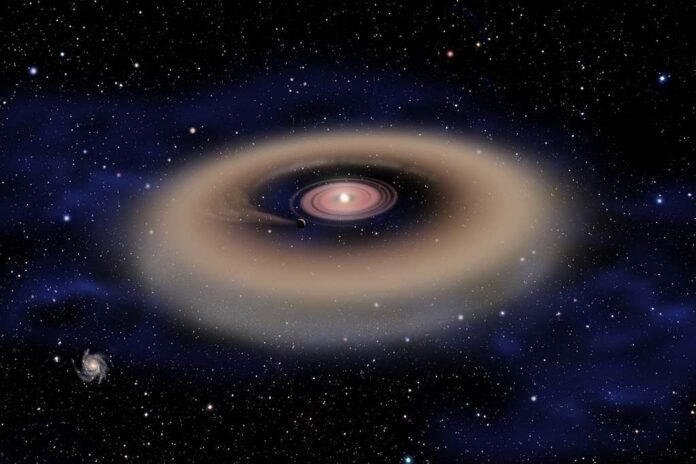Astronomers using NASA’s James Webb Space Telescope (JWST) have discovered unexpectedly thick slabs of high-altitude clouds in the atmosphere of a Jupiter-mass exoplanet in the YSES-1 system. Rather than consisting of water vapor as on Earth, these clouds appear to be made from mineral dust such as magnesium silicates and even metallic iron—droplets that, when the clouds break, could literally “rain” molten iron onto the planet’s surface. The findings, published today in Nature, provide an unprecedented look at atmospheric phenomena during the formative stages of giant planet evolution.
A Young Star System in the Constellation Musca
- Star Age and Characteristics
The host star, YSES-1, resides some 307 light-years away in the southern constellation Musca (the Fly). With an age of merely 16 million years—infantile compared with our Sun’s 4.6 billion years—YSES-1 offers astronomers a rare glimpse into the early days of planetary development. - Planetary Companions
Two directly imaged gas giants orbit YSES-1:- YSES-1b: The inner planet, approximately 14 times Jupiter’s mass, orbits at about 450 astronomical units (AU).
- YSES-1c: The outer planet, at roughly six times Jupiter’s mass, travels in a wider orbit near 600 AU.
Both planets remain hot and luminous, still glowing from the energy of their formation—conditions that make direct imaging feasible with powerful instruments like Webb’s Near-Infrared Camera (NIRCam).
Webb Observations Reveal Mineral Clouds
- Simultaneous Imaging of Two Planets
When the JWST observations commenced, researchers were surprised to capture clear images of both YSES-1b and YSES-1c in the same NIRCam field. This serendipitous double capture allowed a comparative study of two coeval gas giants under identical observing conditions. - Spectroscopic Signatures of Clouds
By analyzing near-infrared spectra, the team detected broad opacity features at wavelengths around 1.2 to 2.5 microns—far too subtle to arise from water vapor alone. Instead, the signatures matched models of high-altitude clouds composed of submicron magnesium silicate (MgSiO₃) dust. Additional weak absorption at 0.9 to 1.1 microns hints at iron droplets suspended in the upper atmosphere. - Iron “Rain” Hypothesis
Dr. Kielan Hoch, an astrophysicist at the Space Telescope Science Institute and lead author on the study, explained the phenomenon: “The presence of iron in these clouds suggests that, when the temperature and pressure conditions change—perhaps at the cloud’s base—molten iron droplets could form and fall, effectively ‘raining’ iron down through the atmosphere.”
Such “metal rains” have been theorized for hot, close-in exoplanets but are now confirmed for a young, wide-orbit gas giant, indicating that mineral precipitation may be a universal feature of giant planet atmospheres.
Implications for Planetary Formation and Evolution
- Atmospheric Dynamics
The detection of mineral clouds at such extreme altitudes challenges existing models of atmospheric circulation and condensate chemistry. Ordinarily, heavy minerals like silicates and iron are expected to condense deeper in the atmosphere; their elevation implies vigorous vertical mixing and strong updrafts in YSES-1c’s weather systems. - Comparative Planetology
Direct imaging of both gas giants allows for direct comparison. While YSES-1c displays prominent mineral clouds, initial spectral data for YSES-1b show a much thinner or absent cloud layer despite forming in the same natal disk. The diversity suggests that even coeval planets can develop markedly different atmospheric structures—likely tied to differences in mass, incident stellar flux, or internal heat flows. - Slab Clouds vs. Patchy Clouds
Webb’s photos indicate that YSES-1c’s clouds form extensive, thin “slab” layers rather than patchy storm decks. These uniform sheets of condensates may create a strong greenhouse effect, trapping the planet’s internal heat and affecting its cooling and contraction over time.
Dusty Disk Around the Inner Planet
- Unexpected Circumplanetary Material
In addition to atmospheric clouds, the JWST data revealed a disk of fine dust encircling YSES-1b. Infrared excess emission at 3–5 microns indicates a debris ring—an outcome not predicted by standard formation models, which suggest that any circumplanetary dust should dissipate within the first five million years after formation. - Formation Theories Challenged
Planetary formation simulations predict that large satellites and ring systems can form around gas giants, but a dusty ring at an age of 16 million years is surprising. Dr. Hoch noted: “Why has YSES-1b retained a dust disk while its sibling lacks one? Both planets formed together—so there must be additional factors, such as moon formation processes or differing impact histories, that determine disk longevity.”
Future ALMA and JWST observations of the disk’s structure and composition may shed light on satellite formation and debris accretion in young planetary systems.
Future Research Directions
- Time-Resolved Spectroscopy
Monitoring YSES-1c over its 8-hour rotational period will reveal how cloud cover varies with longitude, offering three-dimensional maps of atmospheric features and wind patterns. - High-Resolution Imaging of the Dust Disk
JWST’s Mid-Infrared Instrument (MIRI) and ground-based observatories like the ELT (Extremely Large Telescope) will probe the spatial structure of YSES-1b’s circumplanetary disk—key to understanding ring‐moon interactions and debris dynamics. - Comparative Surveys
Extending similar observations to other directly imaged gas giants—such as those in the HR 8799 or PDS 70 systems—will establish whether high‐altitude mineral clouds are common in young exoplanets or unique to YSES-1c.
Conclusion
The discovery of silicate and iron clouds blanketing YSES-1c’s atmosphere represents a milestone in exoplanet meteorology. It demonstrates JWST’s unprecedented capability to probe the complex weather systems of distant worlds and challenges our theories of cloud formation, atmospheric dynamics, and circumplanetary debris evolution. As data continue to flow in, the YSES-1 system will remain a prime laboratory for unraveling the physical processes that shape giant planets in their infancy—insights that may one day inform our understanding of early Jupiter and Saturn in our own solar system.
READ MORE: Lack of Key Mineral Induces Male Mice to Develop Ovaries
